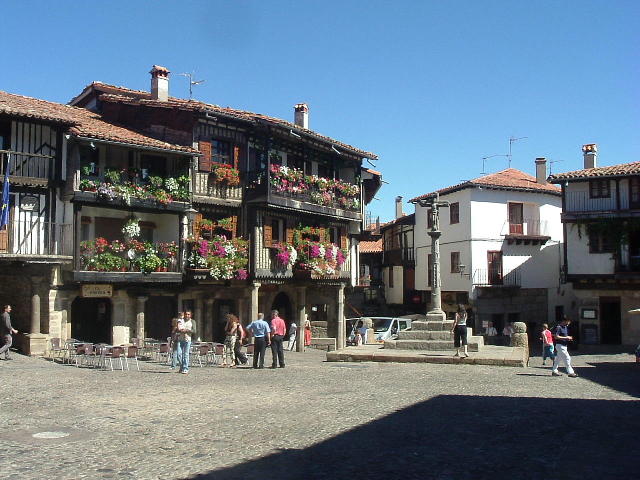I’ve met several people who won’t go to Spain any more. They say it’s crowded with the loud, noisy, vulgar kind of holidaymaker they try to avoid. But, that’s true of only an infinitesimal part of Spain. It’s a big country, and much of it remains that is unspoilt, and inescapably Spanish.
I usually go to Spain as an ‘Anglo’, or English speaker, in an English language programme; some details on my ‘Vaughantown’ page. Although it is work, you have fun, meet a lot of Spanish people you wouldn’t ordinarily meet and form lasting friendships.
A big plus is that the programmes take place away from tourist crowds; in most cases, in places you’ve never heard of, but charming, nevertheless. On my first visit, we went to La Alberca, about 35 miles (60km.) southwest of Salamanca, at the foot of the Sierra de Francia mountains. There were a few tourists, true, but most of them were Spanish or Portuguese; the border with Portugal isn’t far away.
It’s difficult to talk about La Alberca without lapsing into cliché. The moment I walked into main square, the cobbled Plaza de Mayor, surrounded by three- and four-storey, half-timbered houses, I thought of a film set for a mediaeval epic.
And, from the shaded balconies hung a profusion of flowers, making the viewer think, for a fleeting second, he’d been transported from Spain to Bavaria or the Tirol.
La Alberca is the best-known town in this area, and the first of Spain’s country villages to be granted the status of a National Historical Monument.
We often walked with our Spanish companion around La Alberca, talking as we went, often, to make a small purchase … or, sometimes, a larger one, at the carniceria, or butcher’s shop.
The area is famous for its jamòn, or ham. The pigs eat the chestnuts from the trees which clothe the area … after the humans have taken their share, for these are the edible Sweet Chestnut. There’s a statue of a pig outside the church; in the Middle Ages, a pig was left to roam the village, being fed by the villagers on their scraps. When it was killed, the meat was shared among the poor.
At that time, say some, there were still large Jewish and Moorish communities in the area, and the custom had the ‘bonus’ that anyone seen recoiling from the pig could, shortly afterwards, expect a visit from the Inquisition!
We usually made time to explore the narrow streets of La Alberca, and marvel at how modern things like TV aerials, satellite dishes, tourists and cars could be … absorbed! And, you’re just as likely to see a farmer leading a donkey as you are to see a car in those streets.
One day, we had longer than usual to spend in the village. Some of us visited the Satùr Juanela Museum, in the Calle Meson. It’s a four-storey house, where the Juanela family lived and worked, which has been carefully restored to a condition in which they would have known it.
This, I was surprised to learn, was how they lived only fifty years ago! But, that lifestyle hadn’t changed for ten times that length of time.
While at the museum, don’t forget the outside, for the view of the red-tiled roofs, with the TV mast topped mountain Peña de Francia in the distance, is definitely one for the camera.
We would have liked to stay longer at the museum, but the time was drawing close for us to meet with the others at a bodega for wine and tapas. But, the museum curator wouldn’t let us go without a glass of non-alcoholic schnapps, and a small piece of wafer-like bread.
We found the bodega, like La Alberca itself, nearly a little too good to be true; almost a caricature of everyone’s idea of a ‘typical Spanish bar’. Rough stone walls adorned with bullfight posters, a primitive bar, drying herbs … and, of course, a wall lined with dusty bottles, looking like they’d been there since Napoleon passed this way.
A couple of evenings later, we went to dinner at the Hotel Doña Teresa in the Paza Mayor, to find the atmosphere had changed. The market stalls had gone, but the place was still bustling. People sat on chairs outside the numerous bars, cafés and restaurants around the square, having a drink before dinner.
Today was the first Thursday in the month, when the women of the village would parade through the streets around midnight. They would pause by the church, and there pray for the souls of the poor and the criminals whose mortal remains lay in the ossuary, outside the church.
We set up some drinks and waited . Midnight came, and nothing happened. Eventually, around one o’clock, we heard a hand bell tolling, shortly after which the procession arrived.
Truth to tell, it wasn’t the kind of procession we’re used to. The women wore everyday clothes, and just paused briefly by the church before moving on. And, I think what we were witnessing was a genuine act of devotion, rather than ‘something for the tourists’
As we watched the procession, we could hear the faint tones of a disco from one of the bars. But, the women paid it no attention. Another example, maybe, of the ancient co-existing with the modern?





Leave a comment